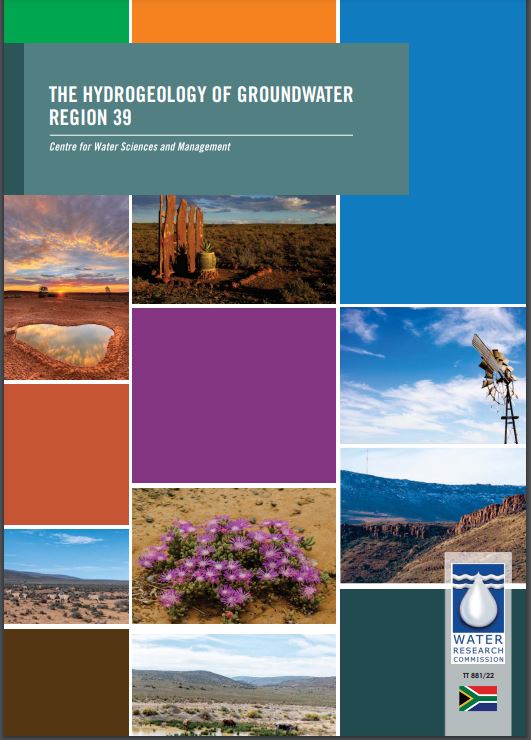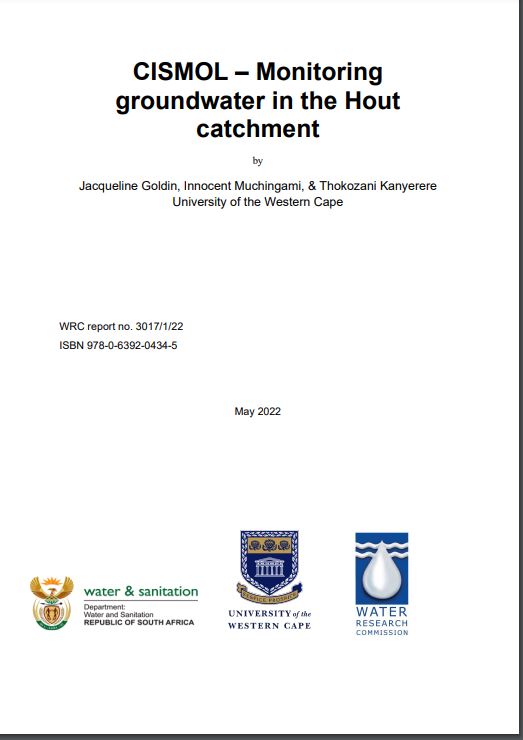A number of WRC important GUIDELINE documents have recently been published on its KNOWLEDGE HUB. We herewith spotlight a few really great recent publications by our Members but please make sure to visit the HUB where there is a number of just as pertinent and very relevant documents available!

|
The hydrogeology of groundwater Region 39
May 31, 2023 | Size: 10703 Kb
TT 881/22
WRC DOWNLOAD LINK
Executive Summary Vegter Region 39 is located in the central Karoo. Groundwater resources within the study area is an important source of water for many towns, farmers and domestic users. However, this resource plays a key role in sustaining many of the ecosystems (e.g. those found at springs and wetlands) within the area. In order to obtain a better understanding the groundwater resources within Region 39, current available groundwater information was statistically analysed according to Vegter’s methodology.
The geostatistical analyses for the study as a whole are discussed and also the individual analysis of the different geological units as identified in the 1:1 000 000 simplified geological map of the area. Vegter’s methodology is followed as closely as possible. The proposed delineation method, based on the work of Vegter (2001) provides a methodology in which aquifers can be delineated. This allows the groundwater specialists to conduct studies/research on aquifer boundaries which deviates from the current approach of using surface water boundaries to delineate study areas. This approach can for example be applied in Groundwater Resource Directed studies. This method is not subjective and repeatable. It is however dependent on data availability. The method can also be applied at different scales, thereby becoming a planning tool for potential sites where field work can take place, for example borehole siting.
This study can also be applied in conjunction to the work conducted by Cobbing et al. (2014), which documents the diverse factors influencing long-term success of groundwater schemes for domestic water supplies. Additional aims of the project were to: (i) analyse and present the related groundwater data in a concise manner, (ii) estimate how much water is available for use and how much is currently being used, (iii) identify possible pollution sources and associated impacts, and (iv) to provide guidelines for the future development and management of groundwater resources. The Reserve was determined together with the groundwater stress index.
|

|
CISMOL – Monitoring groundwater in the Hout catchment
May 30, 2023 | 3257 Kb
3017/1/22
WRC DOWNLOAD LINK
This report brings together the key findings of deliverables three, four and five. As deliverable two is a training manual and a standalone report, it is not included in this final report. In Section one we begin by offering an overview of the conceptual framework for Citizen Science (CS). Section two presents the key findings for the Monitoring and Evaluation Report (MER) which was presented as deliverable four. This is followed, in section three, by an overview of Participatory Action Research (PAR), presented in this project as deliverable five. We then conclude the final report with a summary of key insights from the three sections. The following project aims of the Citizen Science project entitled Citizen Science: Groundwater Monitoring in the Hout Catchment (CISMOL) are addressed in this report.
1. Train citizens on the use of appropriate technology to obtain relevant data on groundwater and rainfall
2. Improve the understanding of hydrogeological processes and groundwater-related socioeconomic and agricultural issues in typical geological settings and farming communities in RSA, exemplified by the Hout/Sand River Catchment in the Limpopo Province
3. Define and promote sustainable groundwater management options in the Hout/Sand Catchment based on integrated hydrological modelling, resource indicator tools, and stakeholder engagement (citizen science)
4. Improve existing training material (completed as deliverable two) 5. Develop and implement a CS framework (completed as deliverable three) 6. Develop a verification and validation system to monitor and evaluate and report on the progress of CS.
|
|

|
I
Guidance Document on Groundwater Scheme Development
May 25, 2023 | 2582 Kb
TT 903/22
WRC DOWNLOAD LINK
The Strategic Water Sector Cooperation between Denmark and South Africa is long-term bilateral cooperation contributing to the South African water sector by sharing practical experience and providing expert input into the South African municipal sphere gaps. The cooperation support intends to add long-term value to optimise groundwater utilisation. This project aims to facilitate the development of guidelines for groundwater schemes at the municipal level.
Table of Content
INTRODUCTION
NEEDS ASSESSMENT
LEGISLATIVE AND PERMITTING REQUIREMENTS
GROUNDWATER EXPLORATION
BOREHOLE DRILLING, BOREHOLE CONSTRUCTION AND PUMPING TESTS
IMPLEMENTATION
OPERATION AND MAINTENANCE
|
 |
Governing Groundwater in City Regions: Water Metabolism and Actor Networks in the Cases of Cape Town and Nelson Mandela Bay
May 20, 2023 | 3623 Kb
3066/1/23
WRC DOWNLOAD LINK
Executive Summary: Patterns of growing urban water demand and increasing drought risk intersect in a context of infrastructure deficits, construction delays and insufficient maintenance in many of South Africa’s metropolitan municipalities. Groundwater is being turned to in times of crisis as a quick solution to supplement supplies and make up surface water deficits, both by public water service providers and private water users, including domestic, commercial and industrial users. Exploiting groundwater during crises, as an urgent and reactive measure, gives rise to poorly coordinated regulation of increasing users and usage, and fragmented management of aquifers. This undermines the sustainability with which groundwater resources are used and managed, putting both aquifers and those reliant on groundwater at risk of over-depletion and pollution.
Designing interventions and innovations that ensure sustainable management of these resources requires systems-thinking, where the city is understood as a system of interdependent actors and flows of water. This study focused on the metropolitan municipalities of Cape Town and Nelson Mandela Bay (NMB) as ‘learning laboratories’ to co-produce a more comprehensive understanding of each urban water system. The focus was on how groundwater links with other urban water flows, what actors influence these water flows, and how things may change under various climate change and land use scenarios.
The work is framed within the idea and the policy goal of cities transitioning to become water sensitive cities characterised by adaptive, multi-functional infrastructure providing access to diverse water sources, urban design that reinforces water sensitive behaviours, and equitable communities that are resilient to climate change. An urban water metabolism (UWM) analysis was conducted to build the picture of how groundwater fits into the urban water cycle by quantifying the hydrological and anthropogenic components and conducting an integrated mass balance.
|
b